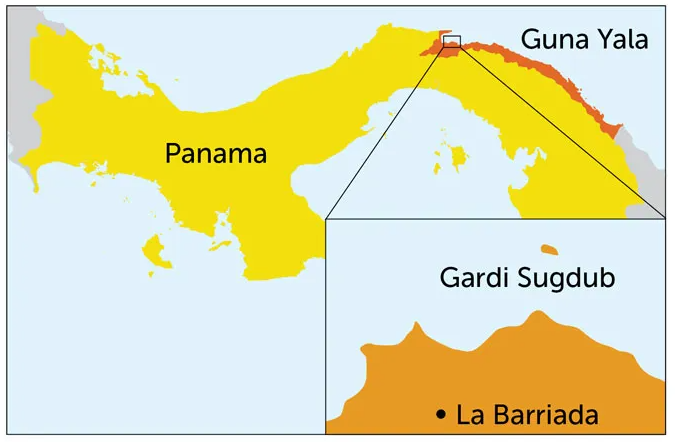Note4Students
From UPSC perspective, the following things are important :
Prelims level: Location of Gardi Sugdub
Mains level: How fast is the global sea level rising?

Why in the news?
In early June, approximately 300 families were relocated from the island of Gardi Sugdub in Panama’s Guna Yala province due to concerns about rising sea levels.
What is happening in Gardi Sugdub?
- Location and Community: Gardi Sugdub, home to about 1,300 members of the Guna community, is an island in Panama’s Guna Yala province.
- Sea Level Rise: The Caribbean region, where Panama is situated, is experiencing sea level rise at an average rate of 3 to 4 millimetres per year. This rate is expected to accelerate to 1 centimetre per year or more by 2100.
- Flooding: Annually, particularly in November and December, seawater floods houses and streets on Gardi Sugdub, despite efforts to fortify the island.
- Relocation: The Panamanian government constructed 300 new houses on the mainland in a development called Nuevo Cartí to relocate affected families.
How are other island nations affected by sea level rise?
- Small island developing states (SIDS) are particularly vulnerable due to their low elevation and reliance on marine resources. SIDS in the Caribbean, Pacific, Atlantic, Indian Ocean, and South China Sea face existential threats from rising sea levels.
- Examples of Impact: Islands such as Tuvalu, the Marshall Islands, and Kiribati are experiencing significant land loss and threats to their culture and economies.
- Consequences: Coastal erosion, salinization of freshwater resources, and increased vulnerability to extreme weather events due to rising sea levels, storm surges, and ‘king tides.’
How fast is the global sea level rising?
- Since 1880, global sea levels have risen by approximately 21–24 centimeters. The rate of increase has accelerated in recent decades.
- Causes: The primary drivers are global warming, thermal expansion of seawater, and the melting of land-based ice such as glaciers and ice sheets.
- Due to the Global Temperature Increase: The global average temperature has increased by at least 1.1 degrees Celsius since 1880, contributing to rising sea levels.
Way forward:
- Strengthen Coastal and Environmental Defenses: Construct seawalls, breakwaters, and other barriers to protect against storm surges and coastal erosion. Restore and preserve natural coastal barriers such as mangroves, coral reefs, and wetlands to enhance natural protection.
- Develop and Implement Climate Adaptation Strategies: Create comprehensive climate adaptation plans that include relocation strategies for vulnerable communities.
Mains PYQ:
Q Explain the causes and effects of coastal erosion in India. What are the available coastal management techniques for combating the hazard? (UPSC IAS/2022)
Get an IAS/IPS ranker as your 1: 1 personal mentor for UPSC 2024
